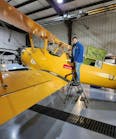WASHINGTON DC – Accident rates for the U.S. civil helicopter industry flattened out during 2017, but remained well below accident totals from three and four years ago. Preliminary data shows that the 2017 accident rate was 3.55 per 100,000 flight hours, compared to an accident rate in 2016 of 3.45.
This 3 percent increase stems from a few months during 2017 with uncharacteristically high accident totals - - 18 accidents in February and 23 accidents in July. Compared to four years ago, however, the accident rate has been cut by one-third. The fatal accident rate also rose slightly year-over-year, but remained lower than the 2017 goal set by the United States Helicopter Safety Team (www.USHST.org).
Total Accident Rate Fatal Accident Rate Annual Goals
2017 3.55 0.59 0.69
2016 3.45 0.54 0.73
2015 3.67 0.52
2014 4.26 0.65
2013 4.95 1.02
Comparing 2017 with 2013 (when the USHST industry-government partnership was created), total civil helicopter accidents have decreased by 17 percent and fatal accidents have been cut by 33 percent.
Total U.S. Accidents
2013: 146 accidents, 30 fatal accidents, 62 fatalities
2014: 138 accidents, 21 fatal accidents, 37 fatalities
2015: 121 accidents, 17 fatal accidents, 28 fatalities
2016: 108 accidents, 17 fatal accidents, 29 fatalities compared to 2013:
2017 121 accidents, 20 fatal accidents, 34 fatalities 17% decrease in accidents
Reducing fatal accidents even further is a central USHST aim. From 2016 through 2019, the USHST is focusing major attention on reducing fatal accidents within the U.S. civil helicopter community. The industry-government partnership is targeting a reduction by 2019 to 0.61 fatal accidents per 100,000 flight hours. The fatal accident rate goal for 2017 was 0.69 or lower, and for 2018, it is 0.65.
Data for 2017 is preliminary and there is potential for at least two more adjustments to the annual rates.
In March 2018, the FAA’s next Aerospace Forecast will be released and an adjustment could be made if the estimated 2017 flight hours shown in the 2018 forecast are different than the 2017 forecast. A final adjustment could occur after September 2018 when the FAA’s 2017 General Aviation and Part 135 Activity Survey publishes data based on rotorcraft flight hours received from operators. It should be noted that in recent years, the FAA Forecast of U.S. rotorcraft flight hours has been within two to three percent of the flight hours published in the annual GA and Part 135 Survey, so adjustments to the rates are anticipated to be minimal.
More information about the USHST, the International Helicopter Safety Team, its reports, safety tools, Reel Safety audio-visual presentations, and YouTube safety videos can be obtained at its web site at www.IHST.org and on the IHST Facebook page.
Safety is Our 1st Priority
